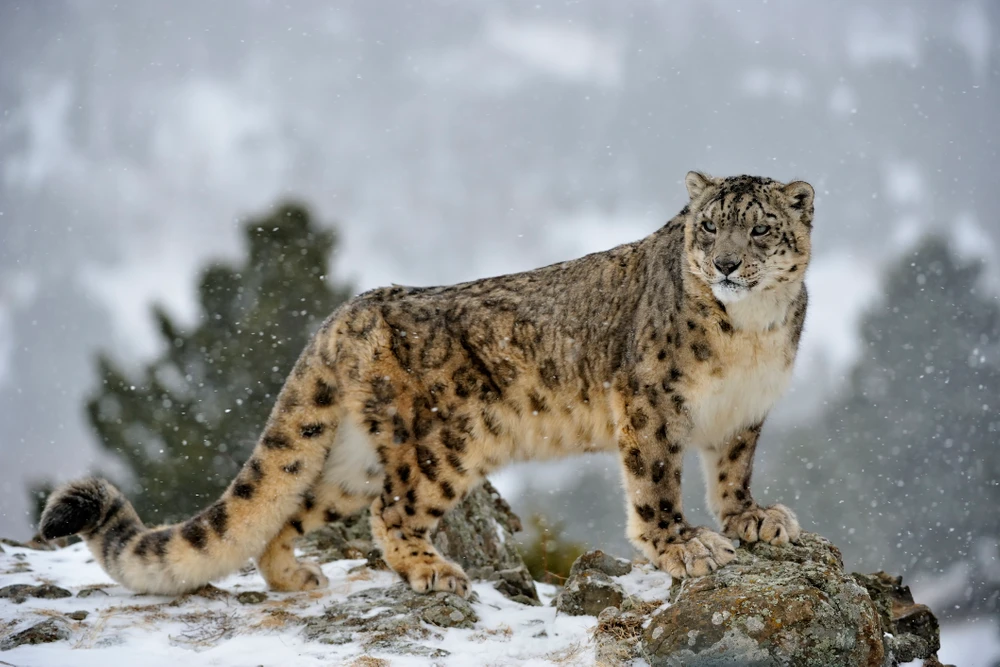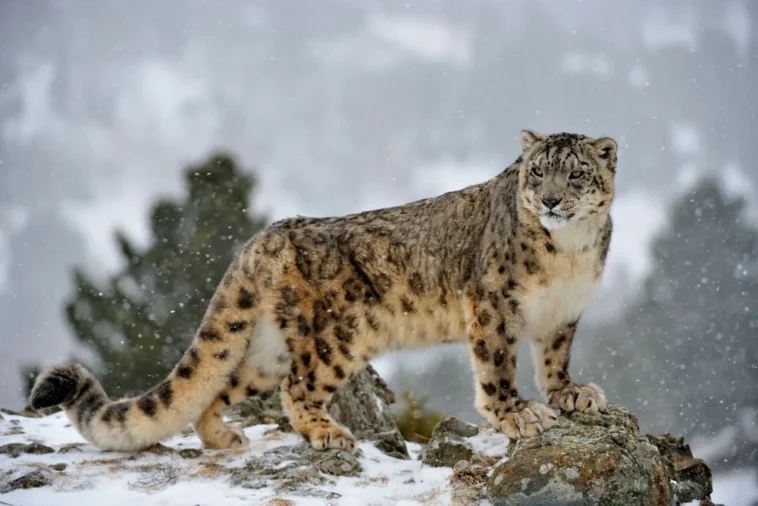The Snow Leopard, also known as the “Ghost of the Mountains,” is a stunning and mysterious creature that inhabits the high mountain ranges of Central and South Asia. With their soft and thick fur, distinctive pattern, and long tails, Snow Leopards are considered one of the most beautiful wild cats in the world.
The Snow Leopard is native to the mountain ranges of Central and South Asia, including countries such as Afghanistan, Bhutan, China, India, Kazakhstan, Kyrgyzstan, Mongolia, Nepal, Pakistan, Russia, Tajikistan, and Uzbekistan. They inhabit elevations ranging from 3,000 to 5,000 meters (9,800 to 16,400 feet) and higher, in areas with rugged terrain, steep slopes, and rocky outcroppings.

Snow Leopard habitats include alpine and subalpine zones, as well as high-altitude deserts and steppes. They prefer open landscapes with low vegetation, which allows them to hunt their prey and escape from predators.
How big is a snow leopard?
Snow Leopards are medium-sized big cats, weighing between 26 and 55 kilograms (57 to 121 pounds) and measuring between 90 and 160 centimeters (35 to 63 inches) from head to tail. They have a stocky build and are well adapted to life in their high-altitude habitat, with thick fur and large paws that help them traverse the snow. Despite their size, Snow Leopards are known for their agility and ability to climb steep slopes and rocky outcroppings.
Snow Leopards are well adapted to their high-altitude habitat, with thick fur that helps them withstand the cold and large paws that help them traverse the snow. They also rely on their environment for food, hunting prey such as blue sheep, ibex, and marmots. They are also known for their incredible strength, agility, and stealth, making them excellent hunters in their natural environment.
Despite their remarkable abilities, Snow Leopards are facing a number of challenges that threaten their survival. Habitat loss, poaching, and illegal hunting for their fur and bones have significantly reduced their populations in the wild. In some areas, Snow Leopard populations have declined by as much as 60% in the last 16 years, and the species is now considered endangered.
Why Snow Leopard is an Endangered Species?
Snow Leopards are endangered due to a combination of factors, including:

- Habitat loss and degradation: Snow Leopard habitats are being lost and degraded due to human activities such as mining, infrastructure development, and agriculture. This reduces the available habitat for Snow Leopards and disrupts their natural behavior and prey populations.
- Poaching: Snow Leopards are illegally hunted for their fur and bones, which are in high demand on the black market. This illegal trade is a significant threat to the survival of the species.
- Climate change: Climate change is affecting the distribution and availability of Snow Leopard prey, putting additional pressure on the species. In addition, the melting of snow and ice in their habitat may reduce the quality and quantity of suitable habitat for Snow Leopards.
- Conflict with humans: Snow Leopards are sometimes perceived as a threat to livestock and humans, leading to retaliatory killings. In some areas, Snow Leopards are also hunted for their hides, which are believed to have magical properties.
Organizations that Work Snow Leopard ‘s Conservation:
There are several organizations working to conserve Snow Leopards and their habitats. Some of the major organizations include:
- Snow Leopard Trust: This is an international non-profit organization that works to protect Snow Leopards through scientific research, habitat conservation, and community-based programs.
- World Wildlife Fund (WWF): The WWF works to conserve Snow Leopards through habitat protection, anti-poaching measures, and community-based conservation programs.
- Snow Leopard Conservancy: This organization works to conserve Snow Leopards and their habitats through community-based conservation programs, habitat protection, and education and outreach initiatives.
- Snow Leopard Foundation: This foundation is dedicated to conserving Snow Leopards through scientific research, habitat protection, and community-based conservation programs.
- Snow Leopard Network: This network is a collaboration of individuals, organizations, and government agencies working to conserve Snow Leopards and their habitats.
These organizations are working to protect Snow Leopards and their habitats through a variety of initiatives, including habitat preservation and restoration, anti-poaching measures, community-based conservation programs, and scientific research. However, much more needs to be done to ensure the survival of this magnificent species and its habitat.
Snow Leopards are not just a symbol of the beauty and power of nature, but also an important indicator of the health of the mountain ecosystem. By protecting Snow Leopards, we are also protecting the other species and the communities that depend on their habitat.
In conclusion, the Snow Leopard is not just a ghost of the mountains, but a vital part of the natural world that deserves our protection. We must work together to ensure the survival of this magnificent species for future generations to enjoy.

